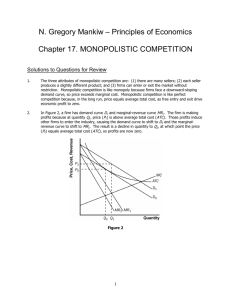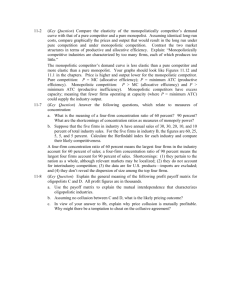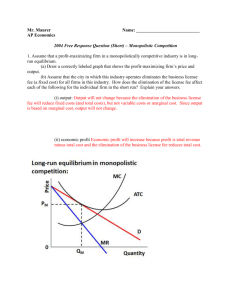Monopolistic Competition: The Competitive Model in a More
advertisement
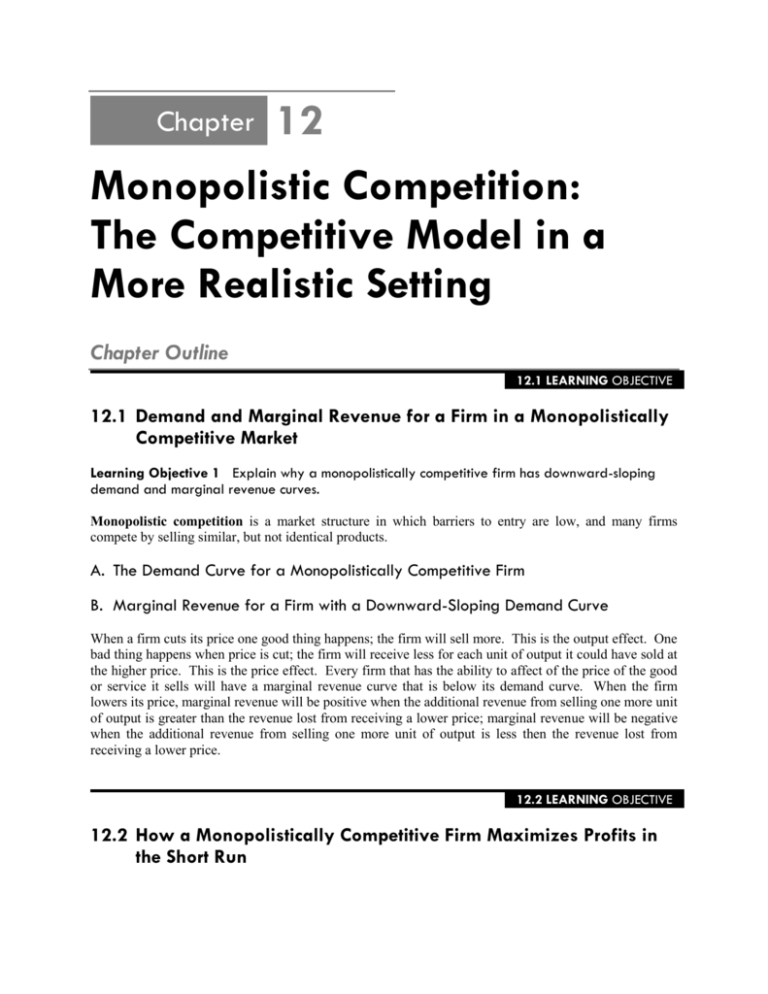
12 Monopolistic Competition: The Competitive Model in a More Realistic Setting Chapter Chapter Outline 12.1 LEARNING OBJECTIVE 12.1 Demand and Marginal Revenue for a Firm in a Monopolistically Competitive Market Learning Objective 1 Explain why a monopolistically competitive firm has downward-sloping demand and marginal revenue curves. Monopolistic competition is a market structure in which barriers to entry are low, and many firms compete by selling similar, but not identical products. A. The Demand Curve for a Monopolistically Competitive Firm B. Marginal Revenue for a Firm with a Downward-Sloping Demand Curve When a firm cuts its price one good thing happens; the firm will sell more. This is the output effect. One bad thing happens when price is cut; the firm will receive less for each unit of output it could have sold at the higher price. This is the price effect. Every firm that has the ability to affect of the price of the good or service it sells will have a marginal revenue curve that is below its demand curve. When the firm lowers its price, marginal revenue will be positive when the additional revenue from selling one more unit of output is greater than the revenue lost from receiving a lower price; marginal revenue will be negative when the additional revenue from selling one more unit of output is less then the revenue lost from receiving a lower price. 12.2 LEARNING OBJECTIVE 12.2 How a Monopolistically Competitive Firm Maximizes Profits in the Short Run CHAPTER 12 | Monopolistic Competition: The Competitive Model in a More Realistic Setting Learning Objective 2 Explain how a monopolistically competitive firm maximizes profits in the short run. All firms maximize their profits by producing where marginal revenue equals marginal cost. Unlike a perfectly competitive firm, a monopolistically competitive firm will produce where P > MC. 12.3 LEARNING OBJECTIVE 12.3 What Happens to Profits in the Long Run? Learning Objective 3 Analyze the situation of a monopolistically competitive firm in the long run. A. How Does the Entry of New Firms Affect the Profits of Existing Firms? When firms earn economic profits, entrepreneurs have an incentive to enter the market and establish new firms. The demand curve of an established firm will shift to the left and become more elastic. Eventually, the demand curve will shift until it is tangent to the firm’s average total cost curve. A firm may suffer economic losses in the short run. In the long run firms will exit an industry if they suffer economic losses. The exit of some firms will shift the demand curve for the output of a remaining firm to the right. Eventually, the representative firm will charge a price equal to average total cost and break even. B. Is Zero Economic Profit Inevitable in the Long Run? Owners do not have to accept breaking even. The key to earning economic profits is to sell a differentiated product or to find a way to produce an existing product at a lower cost. Firms continually struggle to find new ways to stay one step ahead of other firms that attempt to copy their success. 12.4 LEARNING OBJECTIVE 12.4 Comparing Perfect Competition and Monopolistic Competition Learning Objective 4 Compare the efficiency of monopolistic competition and perfect competition. There are two important differences between long-run equilibrium in monopolistic competition and perfect competition. Monopolistically competitive firms charge a price greater than marginal cost and they do not produce at minimum average total cost. A. Excess Capacity under Monopolistic Competition Because a monopolistically competitive firm maximizes profit at an output level that is not the minimum point of its average total cost curve, it has excess capacity. If it increased its output, it could produce at a lower average cost. B. Is Monopolistic Competition Inefficient? CHAPTER 12 | Monopolistic Competition: The Competitive Model in a More Realistic Setting In a monopolistically competitive market neither productive efficiency nor allocative efficiency are achieved; economists have debated whether this results in a significant loss of well-being to society in these markets compared with perfectly competitive markets. C. How Consumers Benefit from Monopolistic Competition The demand curve for the monopolistically competitive firms sloped downward because the good or service the firm is selling is differentiated from the goods or services sold by competing firms. Firms differentiate their products to appeal to their consumers. When firms are successful in differentiating their products, this indicates that some consumers find these products preferable to the alternatives. Consumers, therefore, are better off than they would have been had these companies not differentiated their products. Consumers face a trade-off when buying the product of a monopolistically competitive firm: They pay a price greater than the marginal cost and the product is not produced at minimum average cost, but they benefit from being able to purchase a product that is more closely suited to their tastes. 12.5 LEARNING OBJECTIVE 12.5 How Marketing Differentiates Products Learning Objective 5 Define marketing and explain how firms use it to differentiate their products. Firms can differentiate their products through marketing. Marketing refers to all the activities necessary for a firm to sell a product to a consumer. Marketing includes activities such as determining which product to produce, designing the product, advertising and distributing the product, and monitoring how consumer tastes affect the market for the product. Firms use two marketing tools to differentiate their products: brand management and advertising. A. Brand Management Brand management refers to the actions of a firm intended to maintain the differentiation of a product over time. Firms use brand management to postpone the time when they will no longer be able to earn economic profits. B. Advertising A successful advertising campaign will allow a firm to sell more of its product at every price and it will be able to increase the price it charges without losing many customers. But advertising also increases costs. If the increase in revenue that results from the advertising is greater than the increase in costs, the firm’s profits will rise. C. Defending a Brand Name Once a firm has established a brand name, it has an incentive to defend it. A firm can apply for a trademark, which grants legal protection against other firms using a product’s name. Companies will spend substantial amounts of money to ensure that their brand names are entitled to legal protection. CHAPTER 12 | Monopolistic Competition: The Competitive Model in a More Realistic Setting If its trademarked name becomes widely used for a type of product, the firm may no longer be entitled to legal protection from unauthorized use of that trademarked name. 12.6 LEARNING OBJECTIVE 12.6 What Makes a Firm Successful? Learning Objective 6 Identify the key factors that determine a firm’s success. A firm’s owners and managers can control some of the factors that allow it to make economic profits. Examples include the firm’s ability to differentiate its product and produce a product at a lower average cost than competing firms. Some factors that affect a firm’s profitability are not directly under the firm’s control; for example, increases in input prices. Sheer chance also plays a role in the success of a business.
